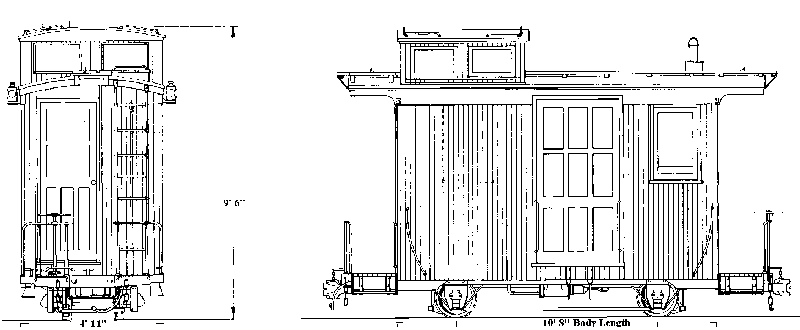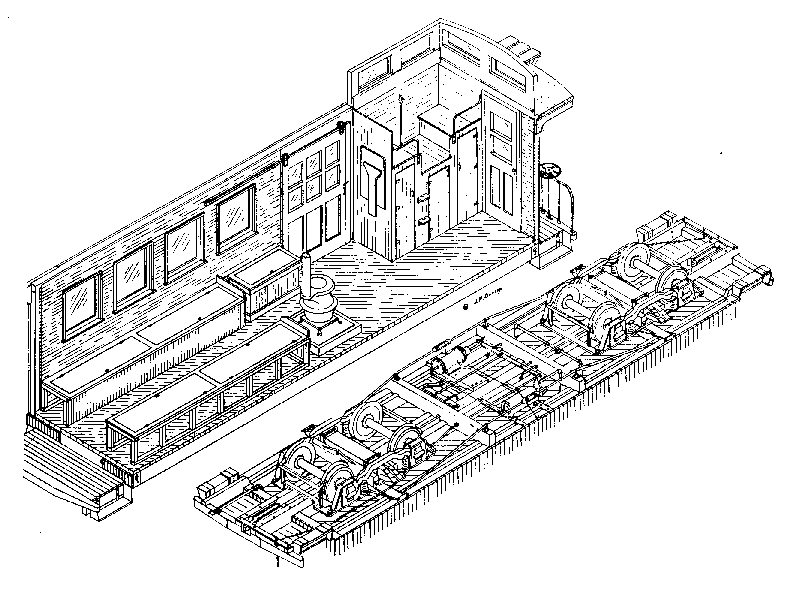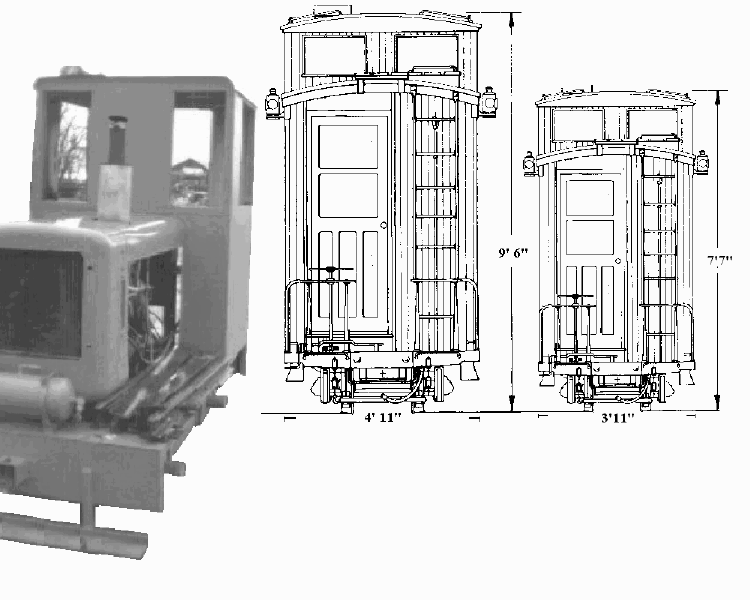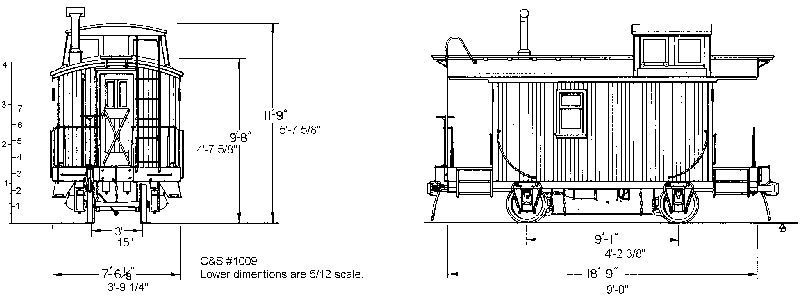A Caboose For Every Use
Subheadings
below:
Design Number One
Design Number Two
Design Number Three
In my quest for a railroad, I have tried to rationalize what the best size, type and proportion would be for our situation. This would not be the best for all necessarily, but best for our use. In the article 'The Railroads of Cottonwood Hill Ranch' in our September 1901 issue [sic], I explained my desire for a full-size narrow-gauge railroad, the justification for such and the reasoning for using Maine two foot gauge at 3/4 size for the basic beginnings and proportions. Here we will try to put that to practical application.
Why
Narrow Gauge
(Yes, I
again feel the need to postulate and muse on the beneficial uses
of narrow gauge, feel free to skip if you get bored)
In scouring borrowed drawings and photos and the few books that I own, I found several that were of interest to this project. Hilton's 'American Narrow Gauge Railroads' is a great reference work on the narrow gauge movement in the United States and the world from about 1870 to the 1960's, though I do not agree with his conclusion that the movement was an utter failure.
The first premise of narrow gauge; its ability to transport goods on any route at a cheaper cost of roughly 1/2 the cost for 3/4ths the cargo was based on inefficient 1870's standard gauge practice and was rendered of less value by 1880s and 1890s advancements in railroad engineering, but the second premise of narrow gauge; the ability to transport smaller quantities of goods cheaper than a 'standard road', was proven quite true by many narrow gauge lines lasting 50 to 100 years with very light traffic.
Though many were 'resource-based' transportion systems, that had little reason to exist when the resource ran out (like our local standard gauge branch lines), the actual reason for the demise of some narrow gauge roads seems to be lack of community interest rather than lack of need for their services. The Bridgeton and Saco River and Nevada County Narrow Gauge come to mind.
Our narrow gauge system is of similar premise: To obstensibly transport goods and passengers around the ranch and have fun doing it!. We have no current need for the kind of size capacity that standard gauge provides and saw no such future need (except, of course, for my multiple caboose 'mobile home train' plan of early years). We have little need for interchange as most of the goods will be unloaded at staging areas for sale and transport elsewhere: Hay to the barn; wood to the corral storage yard; passengers, fruit and vegetables to the fruit stand/ station area.
Here is where there was a quandry: Should we use 'park-sized' equipment or full sized narrow gauge equipment. Here we again didn't need the capacity of the large narrow gauge equipment of 24 or 36" gauge, but didn't like the toy-like look of most park trains for our purpose. I guess we were more into narrow gauge 'critters' than park trains.
I had been keeping my eyes open for good articles in the magazines about 18" gauge operations other than mines. Most of the mines around here were 18" gauge, but were push carts or maybe one electric mine motor. There were a couple of excellent articles on the Morenci Mines Railroad in Southeast Arizona. It was several miles in length and 20" guage. It used a variety of 0-4-0s and 0-4-2s of very large proportions, had passenger cars of a sort and actually a couple of the locomotives are said to be still left out in the desert. 20" gauge was chosen because of its remote location; the first locomotive was actually shipped in pieces by mule train and assembled at the site!
We really could have used 24" gauge park train sizes as they are nearly the same size as our 18" gauge equipment, and will leave the option open for that in the future (all current equipment can be converted to 24" gauge without too much problem if necessary). But we also found that the Maine Two-foot railroads exemplified the carrying of the most cargo possible as compared to track width, had great looks and presented an interesting engineering challenge.
Design Number One
I had pretty much decided on using a shortened Maine prototype caboose for the beginnings of my bobber 4-wheeler from reading the small early book 'Busted and Still Running' about the Bridgton and Saco River Railroad, one of the last of the Maine two-footers to be abandoned to history, though none of their cabooses had a proper cupola like I preferred. I borrowed a book called 'Narrow Gauge and Logging Cabooses' from my brother and found plans for Sandy River and Rangley Lakes cabooses #551 and #556-557. 551 had a near center cupola while 556 had an end cupola that would work well for shortening.

This scan didn't come out too good once I resized it, but you may be able to recognize it as SR&RL #556/557.
I modified the #556 plan to make a presentable work caboose retaining the side door (for tools and cargo), a small but usable cupola and room for several passenger seats, on each side of the center isle.

It is sized at about 75% the width of #556, so other dimentions were sized similarly for the first stage of design. Next the roof was raised to make room for full sized people. I am 6'2" and 245 pounds so I am really more of a broad gauge than a narrow gauge person! The car roof had to be raised substantially. The drawings showed the original doors to be only 5'5" tall, this just wouldn't do! The current bobber plan is 9'6" tall overall, just 1'4" less than the prototype but it is evenly divided: floor height 1'6" (using 12 to 14" wheels), roof height at center 6' 6" (allows inside clearance of about 6' 3" and door height of near 6'), cupola height 1' 6". Our engine house/ workshop is already built with 8' door height however, so I think the best option is to make the cupola removable - talk about an engineering challenge!
The width of 4'11" is about the maximum alowable for stability. #556 had an offset door on the cupola end as the cupola seat was on one side of the caboose only. It works out well in this design, all that was needed was to widen the door to about two feet. I left the roofwalk and ladders on in the drawing, but for practicality they probably won't be installed. The body length is 10' 8" and the end platforms are 18" wide.
We want to build it out of all wood with the exception being a steel tube frame built in each end of the caboose body for structural stability and rollover protection. The walls (and possibly roof and floor) are preferred to be 'Structural Insulated Panels' - foam beadboard sandwiched between structural wood and glued into one solid structural unit about 2" thick. This will make year round running comfortable and make framing quite simple. If we ever put these into production, we can even order the panels factory precut for easy assembly. The underframe will be 4 standard 4x6" beams with 4x4 extensions for the 'porches' or end platforms instead of 6 timbers scaled from a two footer, after all this in not to be a model, but a working piece of equipment.

This drawing is excellent as it shows all the underframe members in a position rarely seen on the prototype. Notice how the end platforms are lower than the car floor because of the platform beams being attached under the main frame of the car.
I think it would be interesting to build an 8 wheel version of this caboose at the full 75% length of #556 which would make for a 16' body, room for more passengers and nearly 20' overall length. I will build the On18 model of this design (a roof leftover from a MDC caboose kitbash looks to be a perfect fit for this), but will have to wait until we come up with some trucks to build the 'prototype'.
Design Number Two
That design will likely work really well for our railroad where we have the clearances set up for such large rolling stock, but for any kind of 'Interstate Interchange' with other railroads, it likely wouldn't work. For this I compared several sizes to see what would be comfortable to sit in and the minimum height that would work for 'stooped walking' and came up with a caboose the same as the bobber in proportion but at about 60% of the full size two-footer, or about 80% the size of design number one. It is then 7' 7" in overall height, 8' 6" body length and 3' 11" wide. The body height is 5' 2" (interior clearance about 4' 11") which most people should be able to 'stoop walk' while holding onto the seats and railings without too much problem. It scales out to 14.4" gauge, but we hope to fit it with multi-gauge axles to run on 14, 15, 16 and 18" gauges.

Here is a combined scan/ photo to show the size relationship between our engine #102, Design #1 (center) and Design #2 (left). They are pretty tall and narrow, but I think by making sure there is plenty of weight in the underframe and trucks and proper suspention and springing, it will work fine. I wanted to put a photo of one of us in there to compare, but didn't want to scare anyone....
Design Number Three
The Idaho Southern and Pacific, proposed 15" gauge/ 5" scale of my brother in Boise, is the most likely place for interchange, but the designs presented so far would not fit in well there. For this I figured I could build a 5/12ths scale caboose modeled after one of a number of prototypes. I am partial to 'real' caboose steps so really like the Colorado and Southern #1006 caboose design:

An easier and as recognizable choice might be the DRG 16' bobber cabooses that had 'strap' steps and a continuous under frame. Most wood framed cars with end platforms and 'regular' steps that cut into the frame actually have frame extensions for the platforms as the SRRL cabooses had. The DRG cabooses were eventually rebuilt to the 8 wheel 0500 series so that is a possibility too. Neither of these 'scale' designs would work for adults, but the kids and dogs would love it!
Contact: unknown1@myrealbox.com
Web design by:
updated 31.01.2002